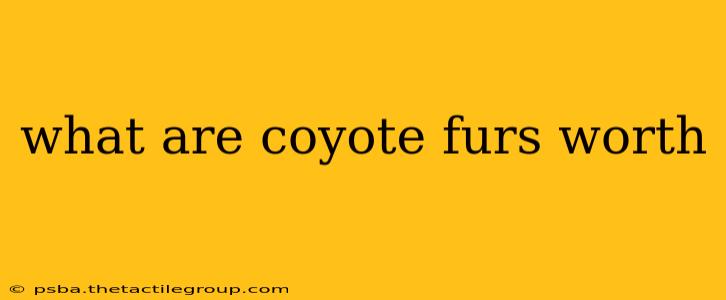Coyote fur, once a staple in the trapping industry, continues to hold value, though its worth fluctuates based on several key factors. Understanding these factors is crucial for trappers, buyers, and anyone interested in the coyote fur market. This guide delves into the intricacies of coyote fur pricing, providing a comprehensive overview of the influences at play.
Factors Affecting Coyote Fur Value
Several interconnected factors determine the ultimate price a trapper or seller receives for their coyote pelts. These factors can significantly influence the final value, sometimes resulting in dramatic price swings.
1. Fur Quality: The Paramount Factor
The quality of the fur is, unsurprisingly, the most significant determinant of its value. Key aspects of fur quality include:
- Prime Condition: A prime pelt boasts a dense, thick underfur, a lustrous guard hair, and minimal damage. Pelts harvested during the peak of the winter season generally achieve this prime condition.
- Size and Body Shape: Larger, well-proportioned pelts command higher prices than smaller, oddly shaped ones. A full, undamaged pelt is significantly more valuable.
- Color and Markings: Certain color variations and markings are more desirable than others. For example, deep, rich colors and unique markings can increase value. However, market trends dictate what colors are most sought after in a given year.
- Damage and Defects: Any damage, including cuts, holes, scars, or urine stains, will negatively impact the price. Proper handling and care during trapping and processing are vital to preserve pelt quality.
2. Market Demand and Trends: Global Influences
Global fashion trends and the overall demand for coyote fur significantly influence pricing. Fluctuations in demand from furriers and garment manufacturers directly impact prices paid to trappers and fur buyers. Changes in consumer preferences can lead to increased or decreased demand for specific types of coyote fur. Understanding these trends is crucial for maximizing profit.
3. Supply and Availability: The Law of Supply and Demand
The basic economic principle of supply and demand plays a crucial role. If the supply of coyote pelts exceeds demand, prices will generally fall. Conversely, if demand surpasses supply, prices will tend to rise. This dynamic interaction significantly influences the market's overall pricing.
4. Geographic Location: Regional Variations
Pricing can vary depending on the geographic location. Regional differences in fur quality, demand, and the number of trappers operating in a particular area can significantly influence the price paid for coyote pelts. Trappers in certain regions may benefit from higher prices than those in others due to these geographical influences.
5. Grading and Auction Systems: Determining Value
Most coyote pelts are graded and sold through auction systems. Experienced graders assess the quality of each pelt based on the factors mentioned above, assigning a grade that directly correlates with its price. The auction process itself introduces variability, depending on the number of bidders and overall market conditions.
Finding Current Market Value Information
Unfortunately, pinning down an exact dollar figure for coyote fur is impossible without specific details about the pelt's quality and the current market conditions. However, several avenues exist for finding current market information:
- Fur Auctions: Attending or monitoring online fur auction results can offer insights into current pricing.
- Fur Buyers and Dealers: Contacting local fur buyers or dealers directly can provide up-to-date price estimations.
- Online Forums and Trapper Communities: Engaging in online communities dedicated to trapping and fur provides access to information shared by experienced trappers.
Conclusion: Understanding the Dynamic Market
The value of coyote fur is a dynamic and complex issue, influenced by several interwoven factors. Trappers and those interested in the market must carefully consider fur quality, market trends, supply, and regional variations to accurately assess the potential value of their pelts. Staying informed through consistent market monitoring is essential to maximizing profits and understanding this fluctuating market.

